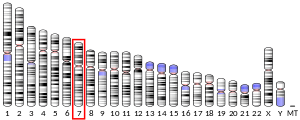HEPACAM2
HEPACAM family member 2 is a protein that in humans is encoded by the HEPACAM2 gene. [5]
| HEPACAM2 | |||||||||||||||||||||||||
|---|---|---|---|---|---|---|---|---|---|---|---|---|---|---|---|---|---|---|---|---|---|---|---|---|---|
| Identifiers | |||||||||||||||||||||||||
| Aliases | HEPACAM2, MIKI, HEPACAM family member 2 | ||||||||||||||||||||||||
| External IDs | OMIM: 614133 MGI: 2141520 HomoloGene: 18724 GeneCards: HEPACAM2 | ||||||||||||||||||||||||
| |||||||||||||||||||||||||
| |||||||||||||||||||||||||
| |||||||||||||||||||||||||
| Orthologs | |||||||||||||||||||||||||
| Species | Human | Mouse | |||||||||||||||||||||||
| Entrez | |||||||||||||||||||||||||
| Ensembl | |||||||||||||||||||||||||
| UniProt | |||||||||||||||||||||||||
| RefSeq (mRNA) | |||||||||||||||||||||||||
| RefSeq (protein) | |||||||||||||||||||||||||
| Location (UCSC) | Chr 7: 93.19 – 93.23 Mb | Chr 6: 3.46 – 3.5 Mb | |||||||||||||||||||||||
| PubMed search | [3] | [4] | |||||||||||||||||||||||
| Wikidata | |||||||||||||||||||||||||
| |||||||||||||||||||||||||
Function
This gene encodes a protein related to the immunoglobulin superfamily that plays a role in mitosis. Knockdown of this gene results in prometaphase arrest, abnormal nuclear morphology and apoptosis.
Poly(ADP-ribosylation) of the encoded protein promotes its translocation to centrosomes, which may stimulate centrosome maturation. A chromosomal deletion including this gene may be associated with myeloid leukemia and myelodysplastic syndrome in human patients.
gollark: ++apioform
gollark: ++apioform
gollark: ++apioform
gollark: ++apioform
gollark: ++apioform
References
- GRCh38: Ensembl release 89: ENSG00000188175 - Ensembl, May 2017
- GRCm38: Ensembl release 89: ENSMUSG00000044156 - Ensembl, May 2017
- "Human PubMed Reference:". National Center for Biotechnology Information, U.S. National Library of Medicine.
- "Mouse PubMed Reference:". National Center for Biotechnology Information, U.S. National Library of Medicine.
- "Entrez Gene: HEPACAM family member 2". Retrieved 2017-09-13.
Further reading
This article incorporates text from the United States National Library of Medicine, which is in the public domain.
This article is issued from Wikipedia. The text is licensed under Creative Commons - Attribution - Sharealike. Additional terms may apply for the media files.



